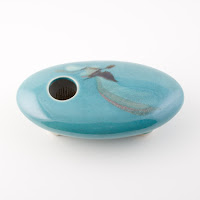Vase for Ikebana is one of the important part for the arrangement. For the intended flowers we can use items that could be found around the house which might be appropriate for the display area.
 Use your imagination, you can have baskets,
glasses, everyday kitchenware, watering can and many other things
because all can be used and has great effect for the arrangement. Even
though there are also varieties types of vases which are designed
special for Ikebana flower arranging.
Use your imagination, you can have baskets,
glasses, everyday kitchenware, watering can and many other things
because all can be used and has great effect for the arrangement. Even
though there are also varieties types of vases which are designed
special for Ikebana flower arranging. To be matched with the intended floral
materials, don’t forget to consider the color, shape, size and texture.
Another thing that you should pay attention on is the display situation
whenever you select the ikebana vase so that’s mean not only the
flower that you should focus on.
To be matched with the intended floral
materials, don’t forget to consider the color, shape, size and texture.
Another thing that you should pay attention on is the display situation
whenever you select the ikebana vase so that’s mean not only the
flower that you should focus on.
A larger and substantial vase is suitable for a dramatic seasonal arrangement
in an entry hall. For other example if you want to put it at a bedside
table you can use a small, less obvious vase and arrangement as it is
more suitable.
For more various shapes such as oval , round,
rectangular or triangular we can use traditional vase called Suiban
(flat bottom, shallow container).
 You can use a low arrangement for dining room
table so people can see over, for this type of arrangement is normally
recommended with diameter of 30 cm and 4-5 cm type of container. A
cylinder or prism-type style has about 30-40cm high, this is a tall
vase type.
You can use a low arrangement for dining room
table so people can see over, for this type of arrangement is normally
recommended with diameter of 30 cm and 4-5 cm type of container. A
cylinder or prism-type style has about 30-40cm high, this is a tall
vase type.
For more modern arrangement or when a certain
height is required then you can use a compote shaped. A heavy and
stable with a small opening vase like Pot is a very suitable container.
We could also use a natural material vase for a nice Ikebana arrangement,
such as Bamboo baskets. Bamboo baskets are suitable for wild
flowers or any flowers that comes from your garden. We could also use
glass containers in many type of shapes. However if you use glass
container make sure you pay attention on the water because the color
changing as the result of immersed stem can be a distracting view.










